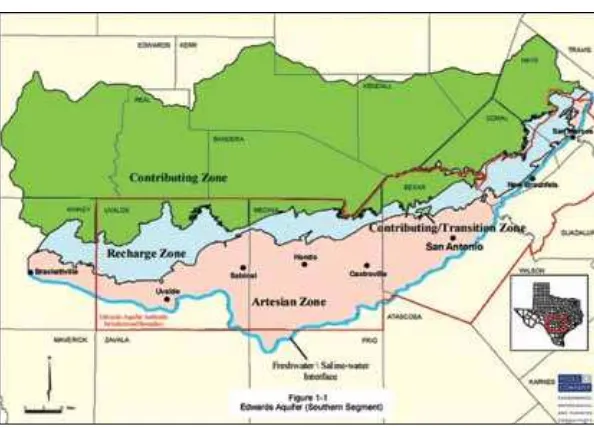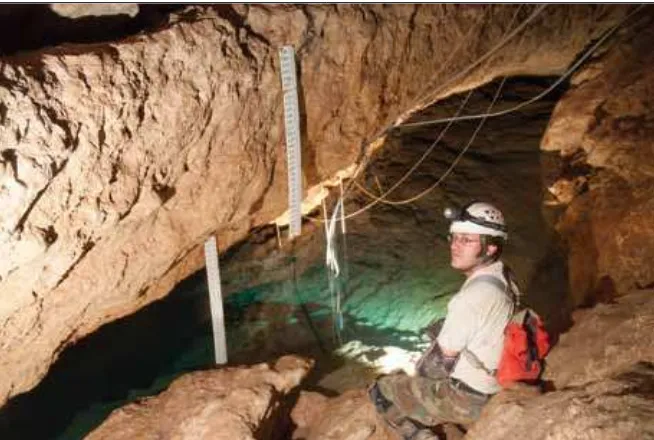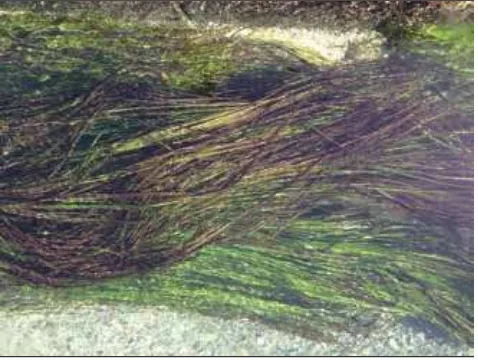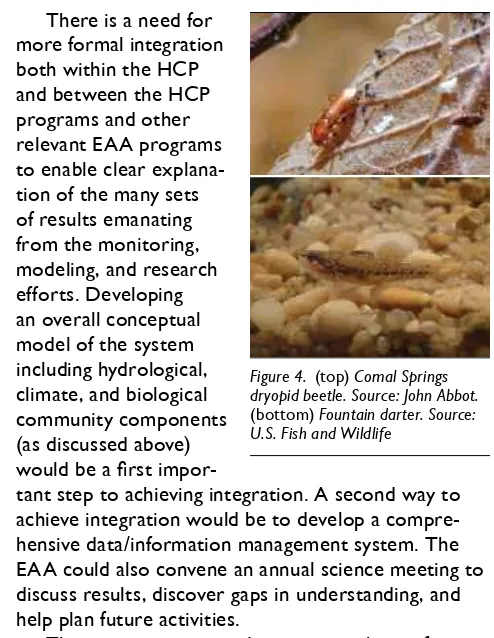WATER SCIENCE AND TECHNOLOGY BOARD
MARCH 2015
Review of the Edwards Aquifer Habitat Conservation Plan
The edwards aquifer is The primary source of waTer for drinking and irrigation in the San Antonio area, and supplies the two largest freshwater springs in Texas, Comal Springs and San Marcos
Springs. Both springs are used for recreation and are home to several species of ish, amphibians, insects, and plants found nowhere else. Seven Edwards Aquifer species are on the federal Endangered Species List because they are vulnerable to reduced spring lows caused by drought and pumping. To protect these species, the Edwards Aquifer Authority and four other local entities have created a 15-year Habitat Conservation Plan. This report is the irst product of a three-phase study to provide advice to the Edwards Aquifer Authority on various scientiic aspects of the Habitat Conservation Plan to help improve the management of the aquifer.
The report inds that overall, the Edwards Aquifer Authority is doing an excellent job in implementing many aspects of a complex habitat conservation plan, and that addressing several overarching scientiic and
modeling issues would further strengthen the plan.
underlain by porous, permeable limestone rock known as “karst,” large volumes of water can move through the Edwards Aquifer’s fractures, conduits,
and cavities in just days. As a result the aquifer responds quickly to both rainfall
events that recharge the groundwater, and to drought and pumping that reduce the
groundwater levels and springlow (see
Box 1).
Rapid declines in springlow can be
catastrophic to the species that live in the Edwards Aquifer and its springs. The seven species listed under the
federal Endangered Species Act (ESA)
are the fountain darter, the San Marcos
gambusia (presumed extinct), the Texas blind salamander, the Comal Springs dryopid beetle, the Comal Springs rifle beetle, Peck’s Cave amphipod, and Texas
wild rice.
To protect the ESA-listed species,
the Edwards Aquifer Authority (EAA)
and four other local entities applied for an incidental take permit under the Endangered Species Act, creating
a 15-year Habitat Conservation Plan (HCP) as part of the application process. The average annual costs of the HCP are between $15 and $20 million. Given
Box 1. a drought of record at edwards aquifer In the 1950s, central Texas experienced what is now called the
“drought of record,” the most severe drought recorded in the
region. During this drought, lows at Comal Springs ceased for four months, and lows at San Marcos Springs were severely reduced.
At current pumping levels, a similar drought today could result in
complete cessation of low at Comal Springs for more than three years, and near cessation of low at San Marcos Springs.
the uniqueness of the two spring ecosystems, the many diverse
projects that make up the HCP,
and the persistence of drought conditions across the region, the EAA requested the input of the National Research Council. This
report is the irst product of a
three-phase study to provide advice to the EAA on various
scientiic aspects of the HCP that
will ultimately lead to improved
management of the aquifer (see Box 2).
hydrologic modeling
Hydrologic modeling is used to create groundwater models that
reproduce known spring lows and can predict: (1) the effects of
potential future hydrologic condi-tions such as climate change and
droughts on spring low, and (2) how management actions will affect water levels and spring lows.
The Edwards Aquifer is underlain by rock of varying porosity and permeability, and has physical features such as conduits, faults, and barriers that complicate modeling efforts. There have been many
efforts to characterize and model the Edwards
Aquifer, most based on the MODFLOW code. The HCP calls for reinement of the MODFLOW program and development of a second inite element model.
The report’s authoring committee found that
EAA could gain eficiency by moving toward a single model that incorporates the best concepts from
existing modeling efforts. Continued development of
“competing” models (i.e., having both a MODFLOW model and a inite element model) is ineficient and unnecessary and cannot be used for assessing model uncertainty. Furthermore, model uncertainty needs to be quantitatively assessed and presented in formal
EAA documents, for example via explicit sensitivity analysis, validating the groundwater model, and
using additional calibration and validation metrics.
Quantifying model uncertainty increases a model’s
defensibility and can provide a reasonable estimate
of model error, which is important information when using a model for management decisions.
ecological modeling
The HCP calls for the development of new ecolog -ical models to predict species population metrics under a variety of potential future conditions. Three endangered species—the fountain darter, the Comal
Springs rifle beetle, and Texas wild rice—have been designated as indicator species within the HCP, and, along with submerged aquatic vegetation, are
the initial targets of modeling efforts. Currently, population dynamics models for fountain darter and
submersed aquatic vegetation are under development. The individual-based model for fountain darter is a scientiically sound approach for modeling population
dynamics that will require extensive data for model
formulation, calibration, and validation. Suggestions Box 2. The Scope of This Report
The Edwards Aquifer Authority asked the National
Research Council to provide advice on the scientiic initiatives underway to support the Habitat
Conservation Plan. This irst report from the
three-phase study focuses on improving modeling efforts
for the Edwards Aquifer, speciically reviewing four scientiic initiatives within the HCP:
1. ecological modeling,
2. hydrologic modeling,
3. biological and water quality monitoring, and 4. applied research.
Later reports will review the performance of minimization and mitigation measures found in
the HCP, including the four spring low protection measures, as well as the adequacy of biological goals and objectives to protect endangered species.
for improving the modeling effort include (1) hosting workshops to deine the questions, formulate the model, and present preliminary results, (2) making clearer links between the monitoring data and the Applied Research projects and how both will be used to inform the modeling, and (3) engaging
modelers with experience in developing similar
individual-based models.
If the Comal Springs rifle beetle is to be an
adequate indicator of some of the other ESA-listed species, it is critical to have a much deeper
under-standing of its spatial distribution, range of potential habitats, and natural history. The degree to which the beetle is a reliable indicator of other species not being
monitored is presently not well understood nor has it
been objectively tested.
Developing an ecosystem-based conceptual model,
or a series of models of increasing resolution, should
be a top priority for the EAA. The conceptual models
should show how water quality and quantity, other
biota, and restoration and mitigation activities are
expected to interact with the indicator species, as well as with all covered species.
moniToring
The HCP requires the development and implementa
-tion of a monitoring plan to (1) evaluate compliance; (2) determine if progress is being made toward meeting the HCP’s long-term biological goals and objectives; and (3) provide scientiic data and feedback
information for the adaptive management process.
The committee found the monitoring programs to be
strong and comprehensive. Nonetheless, it cautioned that results from the monitoring program cannot
be scaled to the entire spring and reach system because the sampling locations were not selected
using randomization procedures. If the EAA inds
it is necessary to provide system-wide estimates of population densities of target species rather than relying on trends at index sites, it will need to carry out special studies or conduct sampling using random-ization techniques.
Annual algal blooms suggest that enhanced
sampling for nutrients is needed to better monitor the
role of nutrient loading in the spring and river systems of the Edwards Aquifer.The current detection limits
for nutrients such as soluble reactive phosphorus,
nitrate and nitrite, and total nitrogen are so high that
signiicant changes in nutrient concentrations could go undetected. Analytical methods should be changed to
lower the detection limits for phosphorus, nitrate and nitrite, and total nitrogen.
applied research program
Critical to the protection of all aquifer species is
knowledge of the species-speciic demography and
ecology, including knowledge of natural
popula-tion luctuapopula-tions. The Applied Research Program is intended to ill knowledge gaps about the endangered
species in the Comal and San Marcos systems,
particu-larly under low-low conditions, and to provide data and information that can be used to calibrate and
validate the ecological methods. The report
evalu-ates the 15 projects that have been funded to date and identiies new study topics that could inform the
ecological modeling efforts.
The report’s authoring committee also found
that the Applied Research Program could be restruc
-tured to help increase the program’s eficiency and
usefulness, and to ensure that the limited funds
available are targeted to priority research needs. For
example, more widely disseminated solicitations for
research under the Applied Research Program would help foster greater collaborationand increase the diversity of thought, understanding, and
perspec-tive. The program would beneit from a more
transparent process for prioritizing and funding the
projects that includes stakeholder involvement and peer review. Finally, the program should offer some longer (e.g., two- to ive-year) projectsin order to
maximize interest and collaboration from the region’s leading researchers.
overarching issues
The EAA is at the beginning stages of implementing a complex HCP and is doing an excellent job in many respects. Nevertheless, there are a number of over -arching issues that, if considered now, could help
Committee to Review the Edwards Aquifer Habitat Conservation Plan: Danny D. Reible (Chair),Texas Tech University, Lubbock; Jonathan D. Arthur, Florida Department of Environmental Protection, Tallahassee; M. Eric Benbow, Michigan State University, East Lansing; Robin K. Craig, University of Utah, Salt Lake City; K. David Hambright, University of Oklahoma, Norman; Andrew J. Long, U.S. Geological Survey, Rapid City, SD; Timothy K. Kratz, University of Wisconsin, Madison; Laura Murray, University of Maryland, Cambridge; Jayantha Obeysekera, South Florida Water Management District, West Palm Beach; Kenneth A. Rose, Louisiana State University, Baton Rouge; Laura Toran, Temple University, Philadelphia, PA; Greg D. Woodside, Orange County Water District, Fountain Valley, CA; Laura J. Ehlers (Study Director), Michael J. Stoever (Research Associate), National Research Council
he National Academies appointed the above committee of experts to address the speciic task requested by the Edwards Aquifer Authority. he members volunteered their time for this activity; their report is peer-reviewed and the inal product signed of by both the committee members and the National Academies. his report brief was prepared by the National Research Council based on the committee’s report.
For more information, contact the Water Science and Technology Board at (202) 334-3422 or visit http://dels.nas.edu/wstb. Copies of Review of the Edwards Aquifer Habitat Conservation Plan are available from the National Academies Press, 500 Fith Street, NW, Washington, D.C. 20001; (800) 624-6242; www.nap.edu.
Permission granted to reproduce this document in its entirety with no additions or alterations. Permission for images/igures must be obtained from their original source.
© 2015 he National Academy of Sciences
Locate additional information, including related reports, at http://dels.nas.edu/wstb Read, purchase, or download a free PDF of this report at http://www.nap.edu
There is a need for more formal integration
both within the HCP and between the HCP
programs and other relevant EAA programs
to enable clear explana -tion of the many sets of results emanating from the monitoring, modeling, and research efforts. Developing an overall conceptual model of the system including hydrological,
climate, and biological
community components
(as discussed above) would be a irst impor
-tant step to achieving integration. A second way to
achieve integration would be to develop a compre -hensive data/information management system. The EAA could also convene an annual science meeting to discuss results, discover gaps in understanding, and
help plan future activities.
There is an urgent need to monitor the
perfor-mance of the HCP’s minimization and mitigation
measures that are being implemented at both Comal
and San Marcos Springs. These include control of recreational activities, removal of exotic species,
riparian restoration and bank stabilization projects. Finally, the Committee recommends that the
EAAbegin to think now about possible worst case scenariosand their potential implications for both
modeling and implementation of the HCP over the
next decade. Examples of potential future “worst case” scenarios worth considering include:
•
Increased groundwater pumping from exemptor unregulated wells that undermines the HCP’s minimum low requirements;
•
Drought conditions that exceed the drought ofrecord from the 1950s;
•
Climate change impacts that become signiicant faster than expected;•
High court afirmation of the Bragg constitutionaltakings decision, which found that limiting
land-owners ability to pump water from Edwards Aquifer
could result in a constitutional taking of their
property rights, requiring payment from EAA;
•
Subjugation to Aransas National Wildlife RefugeEndangered Species Act issues, including the
Whooping Crane. Figure 4. (top) Comal Springs



